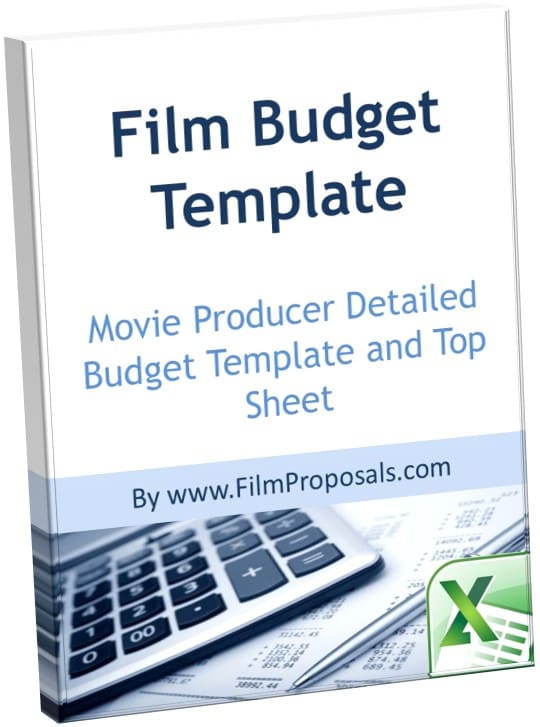
Our film budget template is provided as a guide to help indie producers estimate their movie production costs. The film production budget template can be extremely helpful in determining how and where you can manipulate costs to meet a fixed film production budget.
Alternatively, the movie budget template is a great starting point to demonstrate film negative costs required for the film financial projections and business plans used to secure movie investors.
Film budgeting is extraordinarily complicated, and we highly recommend you bring on an experienced Line Producer to review your financials and help with areas that may need adjusting. Please Note: This tool is limited in scope, and not meant to take the place of more advanced systems, such Movie Magic, Gorilla, etc.
FREE Sample Film Budget Top Sheet
This download is for a sample movie budget template as a static PDF file. Our actual indie Film Budget Worksheet Template is in Excel, fully editable and contains 100s of line items and formulas that can be completely customized to your film production.
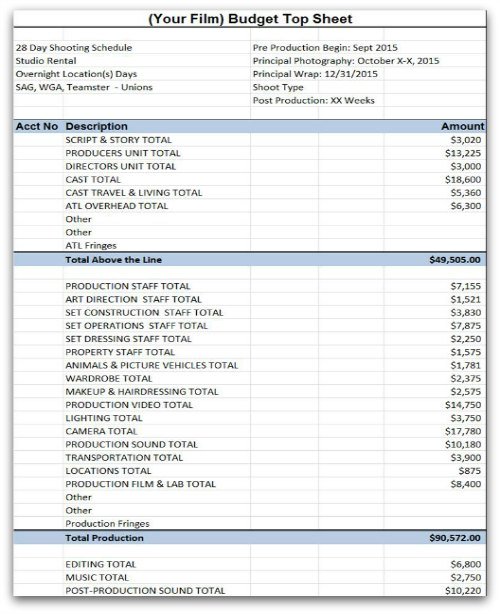
Complete Film Budget Template
Included with select Film Financing Packages & Movie Investor Bundles - The Film Budget Worksheet Template is in Excel, fully editable and contains 100s of line items and formulas that can be completely customized to your film production.
Film Production Budget Sample Template
1. Be Clear on Prep Costs
One of the most under-budgeted areas for first-time film producers is rehearsal and prep costs. Let's say you know a supporting actor is required for five shooting days at the rate of $100 per day. Did you also account for rehearsal time space? Transportation and meals for rehearsals? The cost of rehearsal, without location fees, cameras, lighting and sound is FAR less than production time, so allocate accordingly and work out your kinks prior to production. Most film budgets break their line items down to prep, shoot and wrap to cover pre to post production resources.
2. Know Your "Burn" Rate
The burn rate is the amount your film costs per hour (or other time unit) while filming. Once you budget, add up your total production costs divided by the time unit to get your burn rate. For example:
Your budget shows $100K in total Production Costs over a 30 day Shooting Schedule. That comes to $3,333 per day, $416 per hour (assuming 8 hour days) or $7 per minute. That means, if someone or something takes just 5 minutes longer to do than originally estimated, you've just wasted $35. Obviously, one 5 minute delay should not make or break your production, but keep adding these up and you can easily see how the cost of being stuck in traffic, people showing up late or other filming delays can derail an entire production shoot. Maybe a scene requires one more take more than predicted...but now you've lost daylight...and the whole team has to recreate the scene tomorrow. Keeping your burn rate on the front of everyone's minds helps everyone maintain accountability for the production budget.
Outside of the film industry, people often use burn rates to show the company's cost when an executive is late for a meeting and 10 other executives are sitting around waiting (Executive combined salaries divided by an estimated 2080 paid hours in a work year).
Top of Film Budget Template
Using the Film Financial and Business Plan Templates
For filmmakers who have purchased our Film Financial Projections Template, this sample movie budget template will show you what number to use as your “Film Negative Cost, “ entered into Line #42, usually as the Medium Scenario. The number to use comes from Line #66 of the Budget Top Sheet, “Total Above/Below (Film Negative Costs).”
Keep in mind, Film Negative Costs, a term invented before the era of digital film making, are defined as the costs to, quite literally, create a shipment-ready negative of your film. The film budget template takes you only to this level of funds, and so it is up to the filmmaker to use another form, such as the Film Financial Projections Template, to determine marketing, publicity, film festival and other post production costs. A Business Plan, used for the purpose of raising funds from film investors, will encompass the costs of producing AND distributing/marketing/selling your film.
Excel Requirements
This budget template is not for an Excel novice, nor does it require any advanced Excel knowledge. Some basic skills we recommended to successfully use the template include: understanding numbers vs. formulas, hiding rows and columns, copy and “paste special” including formulas and/or values, and knowing how to trace or follow linked formulas.
Top of Film Budget Template
Film Production Budget Template Best Practices
Film Budget Breakdown and Best Practice Tips
How to structure your feature or short film budget is a must-learn for any aspiring or experienced filmmaker. We know many of you are great at the creative side of filmmaking, but might have questions on how to best finance movies efficiently. You'll want to focus your budget on your talent, equipment, post production and be able to explain to investors and anyone else with a stake in your project your low, breakeven and high scenarios when it comes to ROI, which is dependent on your budget.
Budgeting can be an unpleasant task, especially for "creative type" directors or screenwriters who don't want to sit down and and figure out how much money it is going to cost. However, understanding your budget by creating a detailed breakdown structure, is one of, if not the, most important steps to indie filmmaking.
Once your film budget is structured appropriately, even if it's a low-budget film, you'll be able to spend more energy and time on the things that matter, like directing or producing.
Make Your Actors a Priority
Before you budget for anything else, make sure you budget for your actors. Paying your actors is a big must, and, if you have an experienced actor, you need to make sure you pay them accordingly. By the time you sit down and actually budget your whole movie, you should have your actors cast. That way, you're able to figure out just how much your cast makes, including SAG hires. If your actors are not paid, or don't earn what they're worth, this could leave them unhappy and possibly even lead them to not doing as good a job as when they are at peak performance. This could mean actors do not show up to work on time, something very common to unpaid workers, or their creativity or skill level could drop. It is important to make your actors a top priority on any film.
Your Equipment Budget Is Critical
The second most important aspect of your budget should go to your camera equipment and all the equipment you need to produce high quality material. Trust us, if you try to use the cheaper alternatives in areas like sound equipment, it will be noticeable to viewers. Once you structure your budget around your cast and crew, look at your remaining balance that can go towards your equipment. Of course, there are always ways to find great deals when renting materials like cameras. A lot of people, with the necessary networking and connections, find themselves getting deals others don't on camera equipment all because of those very important connections. We know you've heard this one before, but it's worth repeating again: connections are everything in the film industry.
Make Sure You Budget For Everything Post-Production
A lot of the time, first time filmmakers get caught up in paying actors, crew, and everything necessary to make the film, but then don't take into consideration their post-production budgets. And then the film gets stuck! There is NOTHING more frustrating than to call it a wrap only to find out you have to start asking for more money because you didn't budget for post accordingly. If you think pre-production financing is difficult, post will be 10x more emotionally draining.
Post-production does cost and it should always have a high place when you're first structuring your movie budget. By thinking of the costs that you will have in post-production, you're eliminating the unease that comes quite often when filmmakers realize they don't have the money they thought they did for everything in post. Things like facilities, equipment, and staff are very important to post-production, but every situation varies. Just make sure you keep it in mind when first structuring your budget.
Everything Else
The remainder of your film budget can go in a variety of different areas. Publicity in all its forms, advertising, distribution, you name it. People like attorneys should also be included here, as you may need some legal help in an array of different ways and we always recommend getting professional help in regard to legal issues or contracts. Festivals and all publicity costs should be structured here as well. Again, just like post-production costs, it is much easier to budget prior to even making the movie, even though things like distribution and advertising are probably far from your mind. Setting aside a budget just for these areas will make your overall filmmaking experience flow much smoother than it could if you don't plan accordingly.
Remember to Account for Overtime
On set, overtime tends to be more common than not. Pushing through to get things done for the day is much easier (and even cheaper) than filming an extra day, even though everyone is paid time and a half. Make sure you have a section of your budgeting breakdown structure that accounts for potential overtime during the shooting of your movie. Trust us, by budgeting for it now, you'll be thankful in the long run. If you find yourself filming with the potential of running into overtime, there's no longer that need to rush. When you have a budget for overtime, you can work more freely and stay in the moment.
Make Sure You Plan for Things That Could Go Wrong
Planning ahead for contingencies is always recommended, but hardly ever really enforced in a lot of indie filmmaking. We all know this. Things can go wrong. If you plan accordingly and have a little cushion room in your budget for when Plan A doesn't work, the whole filming experience will immediately feel a bit more comfortable. Don't regret not having a little bit of budget left for when everything goes wrong - because when you don't think two steps ahead, things tend to fall apart and become that much harder to succeed.
The Pig Pyramid
A simple anecdote to illustrate the thought process a good UPM or Line Producer needs to have and how a seemingly simple budget line item could cost you $1000s. A director is thinking about a scene to be shot next week and comes up with a brilliant plan. In a scene, he'd really like a pig to cross frame in the background. It's not an essential story element, it would just be "funny".
I would like to highlight that this story involves adding an element to the shoot which is not "absolutely" needed. It's a background piece that no one would miss. So, keep everything in perspective as you read this and understand what the essence of the example is - not the particulars of the pig or exact rates.
So the director goes to the Line Producer (LP) and tells about the idea. The LP agrees that would be funny, and promises to look into it. A few hours later, the LP informs the director that sadly we really don't have the money to handle putting a pig in the shot in the way you described. The director gets bummed out, goes back to his chair in video village and calls over his assistant.
A few hours later, the assistant returns to the director and tells him he found a pig they could rent for $100. The director furows his brow and heads back to the LP. Confronting the LP with the revelation that the pig is "only" $100 and he does not understand how we would not be able to find such a paultry amount to afford this.
The LP begins to explain, "Sure the pig is $100 for the day, however...
Having a pig on the set means needing animal wranglers. They cost about $42 per hour, on an 8-hour minimum. We'll need two wranglers on the day. Additionally, we'll need one wrangler for the day before to prep the pig. That's about $1300 including fringes.
On the day, I'll need to feed the two wranglers at Catering at $19 a head. I'll also need to feed the pig for $10. That's a total of about $48.
In order to get the pig to and from the set, I'll need a special animal truck. That rents for $375 per day. Fuel for the truck, allow $40. Hire the driver at $31 per hour, 8-hour minimum and add another hour on each end for portal-to-portal on the truck that's about $849 including fringes.
On the set, I need to have an American Humane observer, so that's another $19 for Catering.
For the safety of the crew and the pigs, we should have a holding pen. Renting one could be $100, or we could build one hiring two carpenters to come in, buy the materials and then deconstruct it later for way more - so, let's just rent one from the animal company.
What if the pig does not perform perfect the first take? So, let's have a back-up pig, just in case. Add another $110 for the pig and it's feed."
The LP continues in this fashion for a bit longer, highlighting additional details which may have eluded the director and his assistant as to the finite details of what it really means to have a pig walk across the shot. All told, the LP throws out an approximate total of $3200 for the pig. This does not take into account the fact that if the pig does not perform and we need to retake the shot - the per minute burn on the crew is about $90. It may take 3 minutes to reset everyone between shots - and it adds up even more.
That's the Pig Pyramid. The top point is the pig and each supporting item under it expands out to support the pig. You may apply this concept to almost everything. Every item has a cost or other consideration on cost and logistics. Some are substantial, others are not - yet, all are important. Consider the Pig Pyramid when dealing with aspects for your project, keeping all the appropriate issues in mind.
Another bit of advice is one that another UPM told me when I was a wee tiny PA. She said, "Take it to the end." In this she means, "Have you thought about all the details, have you accounted for everything?" Does A mean something happens now for B? Does that action on B mean that H is affected, and therefore means you need to add a K? An if K is so, does that still mean that B is OK? Start thinking like this and you will begin to see how everything in interlinked - and then you can start to apply costs to those items.
Top of Film Budget Template
More from Film Proposals
- Preparing your first film budget
- Movie Investor Package
FilmProposals - 2025 Financing Toolkits & Bundles
DIY Toolkits, Legal & Finance Service Bundles
See All Financing & Legal Bundles
Gold Toolkit
DIY Templates- Financing Manual
- Financial Projections Template
- Business Plan Templates (Narrative & Documentary)
- Investor Agreement Outline
- Film Budget Template
- Indie Film Pitch Deck
- Custom Indie Film Database
- BONUSES (Dealmaking, Investor Tips, ++ )
- Regular Price $303, Save $124
Gold Toolkit + Financials Bundle
Most Popular- Full Gold Toolkit
- + Professional Sales Projections & Investor ROI (10 Films)
- Regular Price $802, Save $103
Producer's Bundle
NEWEST!- Full Gold Toolkit
- + Professional Sales Projections & Investor ROI -10 Films (Reg $599)
- + Film PPM Investor Agreement (Reg $499)
- + Filmmaker Legal Pack (Reg $129)
- Regular Price $1430, Save $231
While our FilmProposals Bundles & Toolkits will save you hundreds of hours with prewritten text and templates and speed up your learning curve by showing you how to complete complicated financial projections, there is still a lot of information to process. We designed this FREE Film Business Plan Course to be sent once per week to break the process of writing your business plan into manageable pieces, and to keep you accountable and focused.
FilmProposals Tools and Templates
- Film Financing Bundles
- Film Financial Projections Template
- Film Business Plan Template
- Documentary Business Plan Template
- Film Financing and Investor Manual
- Film Budget Template
- Indie Film Pitch Deck
- Film Investor Agreement Outline
- Film Investor Tip Sheet
- Filmmaker Legal Pack
- Indie Film Database
- FREE Business Plan E-Course

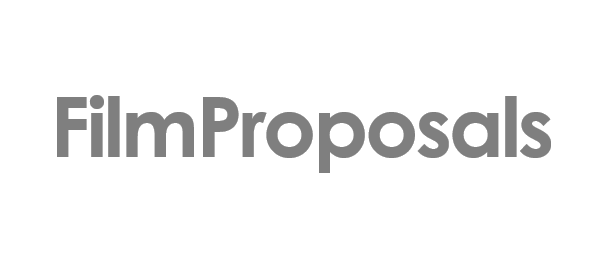

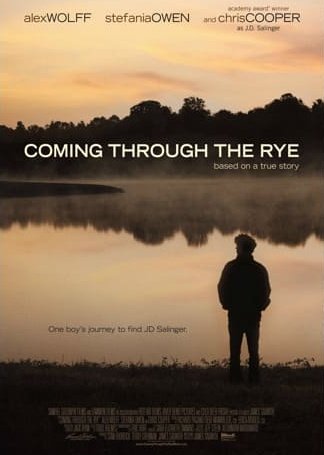
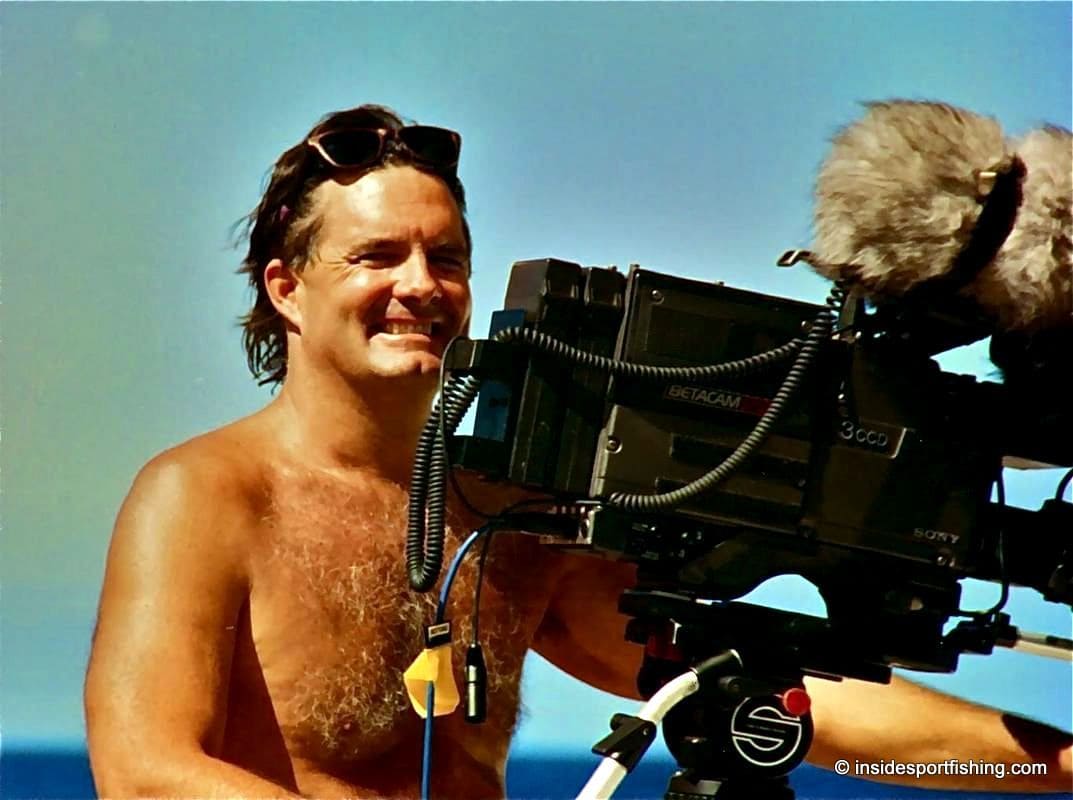

Click to download the FREE Film Budget Top Sheet.